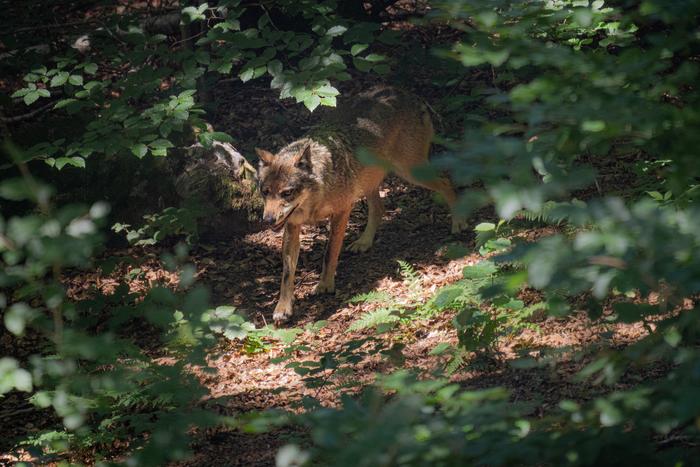The return of the grey wolf (Canis lupus) to Germany, which began 23 years ago in the region of Lusatia in Eastern Germany, is a process of great ecological and social significance. Therefore, a precise understanding of the recolonisation of the original habitat by the grey wolf and a reliable prediction of its future potential distribution are highly valuable. A detailed comparison of different approaches to spatial modelling using 20 years of distribution data now unravelled the complexity of the recolonisation process. A team led by scientists from the Leibniz Institute for Zoo and Wildlife Research (Leibniz-IZW) shows in a paper in the scientific journal Diversity and Distributions that grey wolf habitat selection changed from the early (when they cherry-pick the finest locations) to late phases of recolonisation (when they are much less selective) in a particular area. These results are a refinement of the team’s earlier habitat modelling from 2020, originally published by the Federal Agency for Nature Conservation.

Credit: photo by Jan Zwilling/Leibniz-IZW
The return of the grey wolf (Canis lupus) to Germany, which began 23 years ago in the region of Lusatia in Eastern Germany, is a process of great ecological and social significance. Therefore, a precise understanding of the recolonisation of the original habitat by the grey wolf and a reliable prediction of its future potential distribution are highly valuable. A detailed comparison of different approaches to spatial modelling using 20 years of distribution data now unravelled the complexity of the recolonisation process. A team led by scientists from the Leibniz Institute for Zoo and Wildlife Research (Leibniz-IZW) shows in a paper in the scientific journal Diversity and Distributions that grey wolf habitat selection changed from the early (when they cherry-pick the finest locations) to late phases of recolonisation (when they are much less selective) in a particular area. These results are a refinement of the team’s earlier habitat modelling from 2020, originally published by the Federal Agency for Nature Conservation.
Grey wolves prefer habitats with plenty of cover at a substantial distance from people, their settlements and roads. These preferences were demonstrated during their return to Germany in the 21st century, when they recolonised the habitat from which they had been extinguished 200 years earlier. Knowledge of such habitat requirements and associated preferences also allows predicting the further expansion of their current range in Germany in the future. In 2020, the Federal Agency for Nature Conservation (BfN), in collaboration with a scientific team from the Department of Ecological Dynamics at the Leibniz Institute for Zoo and Wildlife Research (Leibniz-IZW), published a study on modelling suitable habitats. In this study, the team calculated that there could potentially be space for around 700 to 1,400 wolf territories in Germany’s natural areas. The scientists have now taken a closer look and tested a variety of approaches to spatio-temporal modelling with regard to different phases of recolonisation.
“There is reason to believe that the recolonisation of Germany by the grey wolf is not a so-called stationary process, but is characterised by changing framework conditions”, explains Prof Stephanie Kramer-Schadt, Head of the Department of Ecological Dynamics at the Leibniz-IZW. “Stationary processes in this case would mean that the wolves find the same or very similar environmental conditions in the regions into which they newly enter – and that they respond to the environmental conditions in the same way during all phases of the process.” Both assumptions appeared to be doubtful in the case of the recolonisation of Germany by the grey wolf. On the one hand, eastern Germany and the Rhine-Ruhr area in the west, for example, considerably differ in terms of the density of human infrastructure. On the other hand, wolves may show different or varying degrees of habitat preferences depending on whether they move in during the early, first phase or during the late, saturation phase of recolonisation.
“These questions are highly relevant for the quality of the predictions”, says first author Dr Aimara Planillo, a scientist at Kramer-Schadt’s department at the IZW. “If models are developed on the basis of the specific environmental conditions of a particular region, they could underestimate the suitability of another, very different region to which such a model might be applied. At the same time, models created with data from early recolonisation phases may underestimate the suitability of habitats during the late phases – because the wolves during the early phase have a free choice to cherry-pick particular places and habitats and thus appear to be considerably more selective than they will be during the later phases. The reverse is also true: data from late recolonisation phases might suggest that wolves appear to be less selective, which is why the selectivity of their choice and use of habitats in newly colonised areas would probably be underestimated.”
This investigation was conducted by a team led by Dr Planillo and Prof Kramer-Schadt, in collaboration with scientists from LUPUS – the German Institute for Wolf Monitoring and Research –, the Eberswalde University for Sustainable Development, the Technical Universities of Dresden and Berlin, the Humboldt University Berlin, the Federal Agency for Nature Conservation and the University of Veterinary Medicine Vienna. They tested a variety of modern modelling methods and algorithms with data from more than 20 years of wolf monitoring in Germany with particular attention to the potential pitfalls arising from the actual dynamics of the recolonization process. They developed the models on the basis of a combination of radio telemetry and observation data and tested how well they could predict subsequent phases of the colonisation process. “The new models confirmed our previous work in two ways”, conclude Planillo and Kramer-Schadt. “On the one hand, our projections from 2020 were proven to be largely accurate. Secondly, the sometimes significant differences to model forecasts of the various spatial phases of the process show that it is indeed non-stationary”, say the authors. “When recolonising an area, wolves always secure the best habitats first. It therefore appears that they are considerably more sensitive to environmental variables. Neighbouring second class sites are colonised just as reliably in later phases, as we were able to demonstrate in many regions of eastern Germany.” The team was thus able to validate their predictions and refine them in a more differentiated manner. “Spatio-temporal projections of habitats of expanding species should be carried out with great caution”, they conclude.
The most important factors for habitats to be suitable for wolves are close proximity to forests or cover-rich areas and a large distance from roads. The best habitats for wolves are found in the north and northeast as well as in the south of Germany, whereas habitats of lower quality tend to be found in the west. In the south of Bavaria and in some forest areas of central Germany (in the Harz Mountains as well as in the Spessart, Odenwald and Rhön), larger habitats of high quality are still unoccupied by wolves at the time the team ran the analysis. It is likely that the first wolves to arrive there will first settle in prime locations – which by now has already happened according to the most recent data – and colonise medium-quality locations over time. “With regards to our latest modelling and similar experiences from other European countries, where habitats of lower quality are also used permanently when wolf densities are high, previous habitat modelling tends to be too conservative”, says Kramer-Schadt. “However, they provide a good spatial forecast for the initial colonisation of new habitats.”
Journal
Diversity and Distributions
DOI
10.1111/ddi.13789
Method of Research
Computational simulation/modeling
Subject of Research
Animals
Article Publication Date
4-Nov-2023




